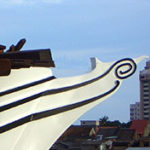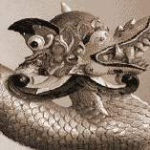Naga Pelangi - the Name
Nāga is a Sanskrit word and means snake. It depicts a mythical snake like creature in the Mahābhārata, one of the two major Sanskrit epics of ancient India. For lack of another word, the modern Malay language uses this Sanskrit word to denominate the Chinese symbol of the dragon.
Pelangi is a Malay word and means rainbow. Therefore in todays Malaysia, Naga Pelangi means Rainbow Dragon. But the name has a deeper meaning, considering the significance of the word Nāga in the olden days:
All over SE-Asia, in Burmese, Thai, Vietnamese, Lao, Khmer and Pre-Islamic Malay culture we find the Nāga, a mythical creature, half snake, half dragon in various forms.


For the Pre-Islamic Malays the Nāga was a deity living in the sea and was held in great esteem by the seafarers. Sacrifices were offered to her for an auspicious journey.
The figurehead of their craft was frequently a carved Nāga. This detailed carving was reduced to a stylized carving in Islamic times, due to the strict picture ban of this religion.The figurehead of a Malay Pinas is called "gobel" and one may guess the old Nāga still shining through.
